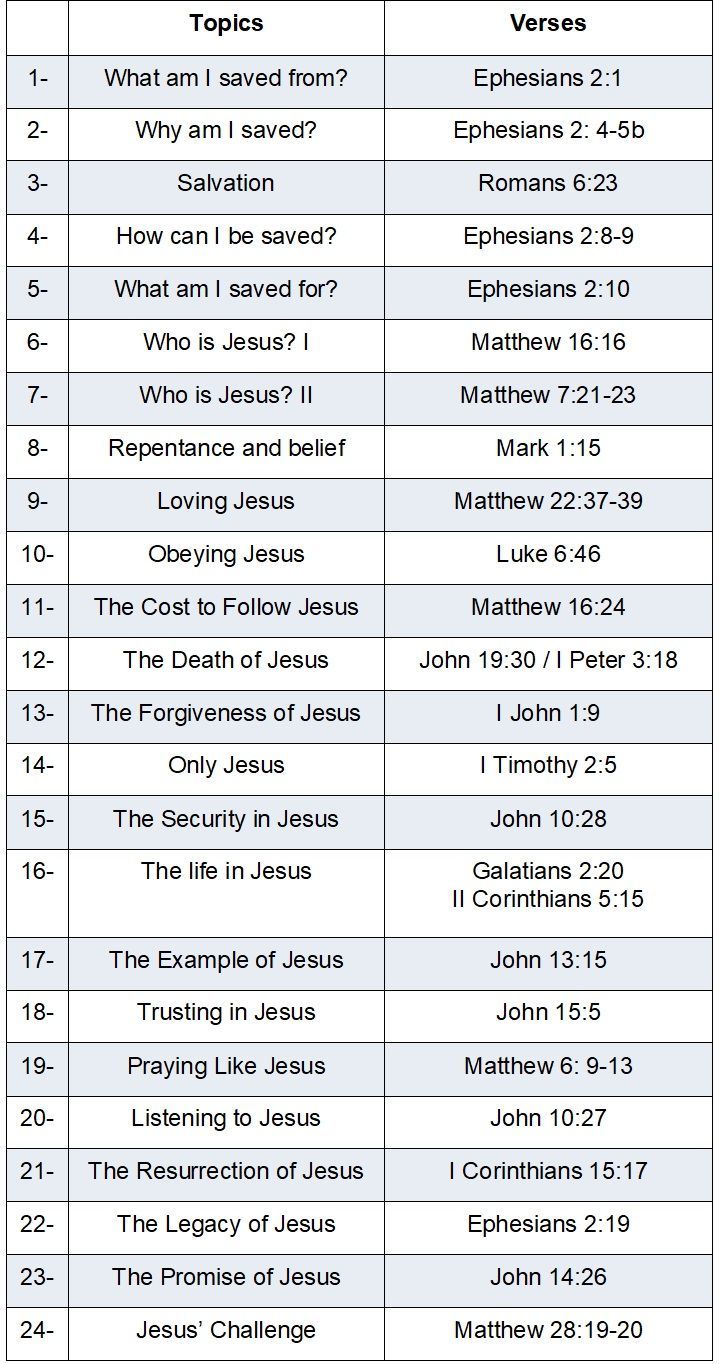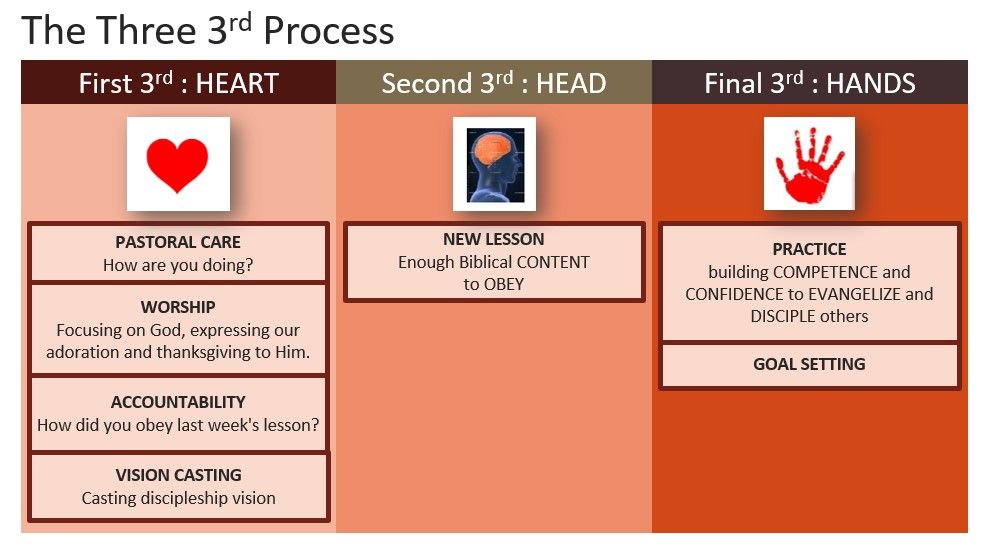One Verse Discipleship
A helpful Tool
with Craig Querfeld
If we want to start a movement of disciples making disciples, we need simple, reproducible tools. We already mentioned in a previous blog on the "3 Thirds Process" (A Multiplication Tool - 3 Thirds Process), that we need
simple tools and
a process that will promote disciple health and multiplication. One suggested tool for the Word time together is "One Verse Discipleship" used by Craig and Sue Querfeld in Peru. In our developing world of diminishing time availablility, especially in cities, this simple approach of Bible based conversation around one verse and one topic could prove to be just the tool you need.
Here is Craig sharing about One Verse Discipleship...
"While Sue and I ministered in Peru, we felt that there was a need to motivate and empower the church to carry on a one-to-one discipleship. In response we developed this
“manual” of discipleship.
Before we delve into the content let me give you some of the background on our thought process.
Some Background
Limitations: We were aware and convinced that discipleship cannot be defined by a series of studies nor can it be limited to a study of a certain amount of verses. This should not be considered the end all of discipleship. It had a certain focus, intended results, and a particular context in which it came about.
Focus: The focus of this “manual” was to
give growing leaders in the church a tool with which they could interact
with young Christians, those who were the process of being established in their faith. Practically speaking it was used with people being prepared for baptism or right after their baptism.
This manual had
a two prong purpose: One to
equip leaders and to
establish new Christians. That is one of the major reasons we used one verse or a few verses. We needed to do something that was
reproducible and understandable for young Christians.
Desired Results: Besides the aforementioned purposes, this tool was meant to motivate and
spur people to spend time in Scripture with others while influencing them spiritually. The church was composed of new believers who had not learned to influence others for spiritual purposes. And secondly, the church people were not used to studying scripture on their own. The hope was that this material would
encourage members to study scripture and then to teach that to others.
With the use of this we were trying to push back on the cultural value that states that only the experts can study and teach the Bible.
Background: The Peruvian culture affected how we designed this. First, Peruvians are not readers. They don’t read much and the whole culture does not encourage it. So we needed to keep this as simple as possible. Yet we wanted to provide some insight and help. Secondly, their model of teaching is imparting information so we wanted to give them tools to move towards a question asking model that would spur the new believer to internalize their faith. Thirdly, we used verses that would help form a Biblical worldview typically parting from their new found faith in Christ.
With these introductory statements, lets move on to explain the methodology.
Content:
The content of the “manual” consisted in a list of the verses.
For each verse we included three sections
- The
Intended goal for each lesson.
- Notes that help the presenter/facilitator understand the passage.
- Questions to ask the new disciple.
Bible Based:
The goal of organizing it in this way was to ensure the primacy of scripture and that the passage in mind was central to the conversation. Even though the emotional state and life situation of the new believer are important we wanted for this
conversation to be centered around scripture.
The idea was that the facilitator would read and study the manual at home but would not bring it to the conversation. The manual would be hidden; it is only a resource to help guide but not the ultimate guide leaving room for other personal questions and doubts. In this way the conversation could be fluid and not bound by a manual that scripts the interaction.
The following were the topics and verses that we chose.
Notes are provided to the Discipler to help them understand the verse themselves and enable them to confidently guide another person in biblical conversation around the verse. Here are a couple of examples of help notes for the leader.
Example #1:
Matthew 16:16
“You are the Christ, the Son of the living God,” said Simon Peter.
Focus: Understanding who Jesus really is
Explanation Notes
• In response to Jesus' question: “Who do you say I am?” Peter makes this statement. This response from Peter is one of the strongest statements about Jesus.
•
The Christ: Refers to Jesus as the anointed and promised of God to fulfill his purposes on earth. The “Christ” (Greek) or “Messiah” (Hebrew) is the same person. Both words mean “the anointed one” or “the sent one.” For the Jews, the Messiah was someone whose arrival they longed for and waited for. Although we are not Jews, Jesus becomes the most anticipated man because through Him we have salvation, hope, and life.
•
Son of God: By referring to Jesus in this way Peter was affirming that Jesus had the same essence as God and that he was God himself. See Philippians 2:6 and Hebrews 1:3.
•
Son of the Living God: Jesus is the source of life. He possesses the strength and power for life.
• Jesus is more than the baby who was born in Bethlehem, grew up, and walked the earth; he is the Savior that all humanity was waiting for.
Application Questions
• Before reading the verse ask: Who would you say Jesus is?
Allow them to respond without interrupting or correcting
• How did you come to that conclusion?
Again, please respond freely.
• Read the verse several times to memorize it.
• Peter had some ideas about who Jesus was. According to Peter, who was he?
The Christ, the Son of the Living God
• What does it mean that Jesus is the Christ?
“Christ” is a term that means the “sent one”; It means that God sent him to pay the price for our sins. All the Jews understood the word.
• What does it mean that Jesus is the Son of God?
It means that Jesus IS God; who has the same attributes as Him. Phil. 2:6
• Combining the two ideas, what does it mean to us—to you—that Jesus, being God, was sent to earth to pay the price for your sins?
That he came for me; that God himself cared about me and saved me
• How does it make you feel?
Let them respond freely; You could mention awe, the desire to serve and obey Him, etc.
Pray together.
Example #2:
Mark 1:15
"The kingdom of God is near. Repent and believe the good news!"
Focus: Understand what it means to repent and believe
Explanation Notes
• This was Jesus' first call for everyone.
• “The kingdom of God is at hand” – here Jesus is making an invitation to men by saying that the kingdom of God is available to all. It is near and not far away, available to all those who wish to enter it.
• In order to enter this kingdom Jesus sets two requirements: repent and believe.
•
Repentance is a radical and total change in our lives.
- A change of my understanding of who he is; He is no longer just a man, but he is my Lord.
- A change in my actions; I no longer do what I want, but I realize that my sin is rebellion against God.
- A change of direction; I no longer follow my own desires but the will of God.
- Repentance is not enough. After deciding what we are NOT going to do, it is necessary to say what we are going to follow.
•
To believe the good news is to put our faith in the person, message, and work of Christ for us.
- Jesus is the Son of the living God and we want to put our faith in Him.
- Jesus proclaimed the message of salvation for humanity.
- Jesus gave himself on the cross to give us new life.
Application Questions
•
Review: Ask him how the commitment he made at the last meeting went and has he kept it. Talk about the results you have seen. If you don't have it fulfilled, talk about why and, at your discretion, decide if you should review the previous lesson or continue.
• Read the verse several times to memorize it.
• Do you remember what we have learned about Jesus in the last two meetings?
He is the Son of the living God and he is our Lord
• What does it mean that Jesus is Lord?
That He is the one who directs my life; I surrender to Him and obey Him.
• Jesus says in this verse that the kingdom of God is near. What do you think that means?
Allow him/her to answer and then clarify anything he/she did not understand. “The kingdom of God is at hand” means that anyone who wishes to enter that kingdom can do so; It is something achievable for everyone.
• Jesus says that anyone who wishes can enter the kingdom of God, but he sets two conditions. According to the verse, what are they?
Repent and believe the good news
• What does it mean to repent?
Radically change my ideas, realize my mistakes, recognize my sin, and ask for forgiveness...
- As I repent I realize that Jesus is not just another man, but who?
My Lord; God himself
- As I repent, I realize that I cannot justify my sin by saying “that's the way I am,” but that sin is a rebellion against God.
- When I repent, I no longer follow my own will, but instead seek to obey the will of who? Of God
- To repent is to change my way of thinking and acting, leaving my sin behind and obeying the Lord.
• What is the second condition that Jesus sets?
Believe the good news
• What is the good news?
The fact that Jesus died on the cross for me, thus providing me with the only way I can receive forgiveness for my sins
• What does it mean to believe that good news?
Have complete confidence in the person, the message, and the work of Jesus on the cross.
• Who is Jesus?
The Son of the living God, my Lord
• What message does Jesus proclaim?
That through Him we can have eternal life
• What did he do to give us that life, that salvation?
He died on the cross, paying the price for our sins
• Do you have entrance to the kingdom of God?
If yes, go to question #18; If you say no or don't know, go to question #19.
• How do you know?
I have repented and believe in the good news; I have accepted Jesus as my Lord and Savior; I have surrendered to him……If you understand, pray together to finish; If you don't understand, go to question #20.
• Do you want to be sure you can enter?
If you say yes or you don't know how, continue with the following questions; If he says no or doesn't care, just finish and pray together. In the next session you should review Romans 6:23.
• According to the verse, what do you have to do?
Repent and believe
• Have you done that?
Guide him to repentance. If you don't seem to understand, go back to the previous questions. Don't move on to the next verse until you understand this one. If necessary, repeat it at the next meeting, or return to Romans 6:23.
Challenge:
This was our attempt to move beyond the institutional discipleship model that the Peruvian church understands and is comfortable in doing by focusing it on small bites of scripture and emphasizing the natural interaction around scripture. This is an imperfect tool and could possibly use another set of eyes and more fine tuning after multiple uses. Please adapt it to your needs and your context. Even now I can see how each of these verses could be changed to different stories for a different cultural and learning context.
I could translate the whole document and send it to you but I fear that it would not meet the particular need and context of your making discipleship journey.
Dream, reflect, bring others into the conversation and come up with your own list of verses and topics and let see what God does with that in your context. Feel free to leave a comment or suggestions below.













